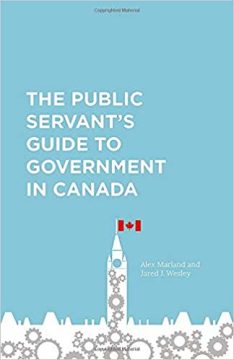Was a book ever timelier? The Public Servant’s Guide To Government In Canada was published following the disastrous YouTube appearance of Canada’s top public servant Michael Wernick, $326,000-a year Clerk of the Privy Council. Just google Wernick and vomitorium if you missed it.
Testifying at the Commons justice committee, Wernick became every critic’s caricature of the Ottawa bureaucrat: peevish, smug, partisan. Wernick in prepared opening remarks used the personal pronoun I nine times: I, I, I, I, I, I, I, I, I.
“I worry about people losing faith in the institutions of governance,” said Wernick. “Tip: Most Canadians don’t follow government activities,” notes The Public Servant’s Guide. “Public servants should bear in mind that many, if not most, citizens do not pay much attention to politics or public policy.”
The Guide is written for public servants by public servants. Co-authors Alex Marland and Jared J. Wesley are political scientists. Yet it has an intriguing, voyeuristic quality for readers who do not and never will work for the government.
I finally learned why senior public employees have Twitter accounts though they never say anything. “Paying attention to what members of cabinet are saying on Twitter helps you stay in touch with their political impulses, which may well have an impact on your own work,” authors explain. “This situational awareness is critical to developing political acumen.”
Canada has about 4 million public employees. There are all kinds, like journalists or insurance brokers: tall, short, thin, fat, sharp, dull. “Be careful not to assume that all municipalities are governed the same way,” says the Guide. “For example, Montréal’s population is over 1.7 million, and Montréalers elect a mayor and 64 councillors to oversee an annual operation budget of approximately $5 billion.”
“Just four people live in Tilt Cove, Newfoundland: one is mayor, two are councillors, and one is town clerk. The population of Tilt Cove nearly triples in the summer when people occupy cottages there. In Montréal, the clerk is a highly paid senior public civil servant who oversees the city’s bureaucracy. In Tilt Cove, the clerk is paid for one hour a week, including for curbside garbage collection.”
The Guide is skillfully written, wry and sometimes funny. “The nuances of Canadian government are not obvious even to those who have spent a lifetime working in public administration,” authors explain: “Within the public service it is said that theory is when you know everything but nothing works; practice is when everything works, but no one knows why; and when theory are practice are combined, nothing works and no one knows why.”
Authors note that “not everything you are good at is something the world needs” and “there will be days when you feel less competent and even less impactful in your work.” Yet public servants should be “fearless” and “loyal.” says the Guide, and “keep your emails short.”
The Public Servant’s Guide is instructive and entertaining. Clerk Wernick could have used a copy.
By Holly Doan
The Public Servant’s Guide to Government in Canada, by Alex Marland and Jared J. Wesley; University of Toronto Press; 128 pages; ISBN 9781-4875-94763; $19.95






